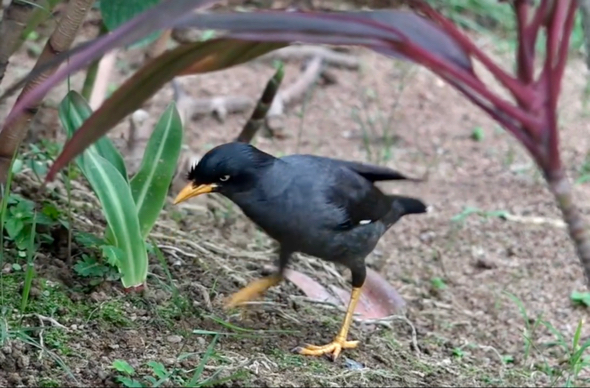An earlier post gave an account of the two adult Javan Mynas (Acridotheres javanicus) teaching a recently fledged juvenile how to forage, etc. For a common species as this, we have no information on how long the juvenile remains with the adults before the former is chased off to lead a life of its own.
Craig & Feare (2009) as well as Wells (2007) give no information on the fledging period of the Javan Myna. Wikipedia gives 22-24 days for the Common Myna (Acridotheres tristis). The definition of fledgling period referred to is after Erritzoe et al. (2007): “the period from leaving the nest to becoming independent of parents.”

How long does the recently fledged juvenile Javan Myna remain with the adults? The resident pair of Javan Mynas in my garden brought in a noisy juvenile on 9th August 2017. This was when I first heard of the begging of a tagging juvenile, so I take this date as the time the chick left the nest.
For the next two weeks the begging cries of the juvenile was constantly heard as the trio moved in and out of my garden. On 22nd August the juvenile and an adult was feeding in a shallow pit filled with compost. As food was plentiful, the juvenile was picking up the compost fauna by itself. After a while the adult walked off, leaving the juvenile to feed alone for the next 20 minutes. Then the juvenile flew off in search of the adults at the back of the garden where the compost bed was sited. Once there, it started its begging cries again. An adult then helped feed it before both flew off.
Two days later the juvenile was still harassing the adults for food even though food was plentiful… see HERE.
The juvenile was seen foraging alone in the garden 25 days after first hearing its begging cries. Then the begging cries were no more heard. A single Javan Myna was seen, sometimes a pair, was seen foraging in the garden (video below).
According to Aviculturist Lee Chiu San, both the birds are adults in the above video. Adults have shiny plumage, looking sleek and shiny. The juvenile’s plumage on the other hand is dull and lusterless, turning sleek and shiny only after the second moult. Also, the birds in the video have bright yellow beaks and feet. Young birds tend to have matte yellow beaks and feet. The yellow in a youngster is more cream coloured rather than lemon yellow. Furthermore, one of the birds has a prominent crest, not as prominent as with the Jungle Myna (Acridores fuscus), but very noticeable nevertheless. Juveniles do not have crests. Also, an adult was seen giving a territorial display, vocalising, puffing up its chest, and generally showing off. Youngsters usually do not have the nerve to do this.
Conclusion: The fledgling period (leaving nest to independent of the adults) of the Javan Myna is about 25 days, after which the juvenile is chased off to fend for its own.
YC Wee & Lee Chiu San
Singapore
17th September 2017
References:
1. Craig, A. J. F. K. & C. J. Feare, 2009. Family Sturnidae (Starlings). In: del Hoyo, J., A. Elliott & D. A. Christie (eds.). Handbook of the birds of the world. Vol. 14. Bush-shrikes to Old World Sparrows. Lynx Editions, Barcelona. Pp. 654-758.
2. Erritzoe, J., K. Kampp, K. Winker & C. B. Frith, 2007. The ornithologist’s dictionary. Lynx Edicions, Barcelona. 290 pp.
3. Wells, D.R., 2007. The birds of the Thai-Malay Peninsular. Vol. II, Passerines. Christopher Helm, London. 800 pp.








